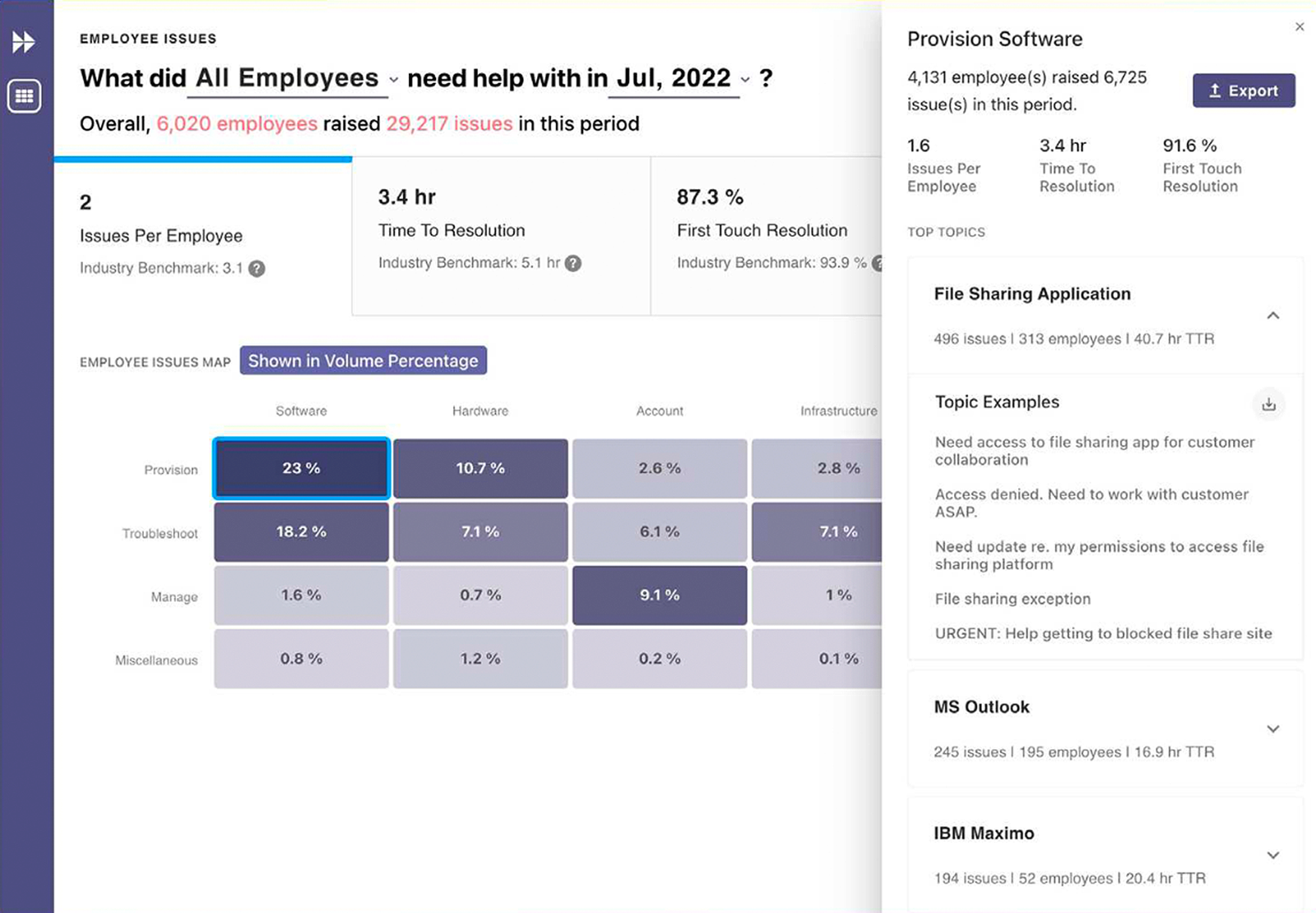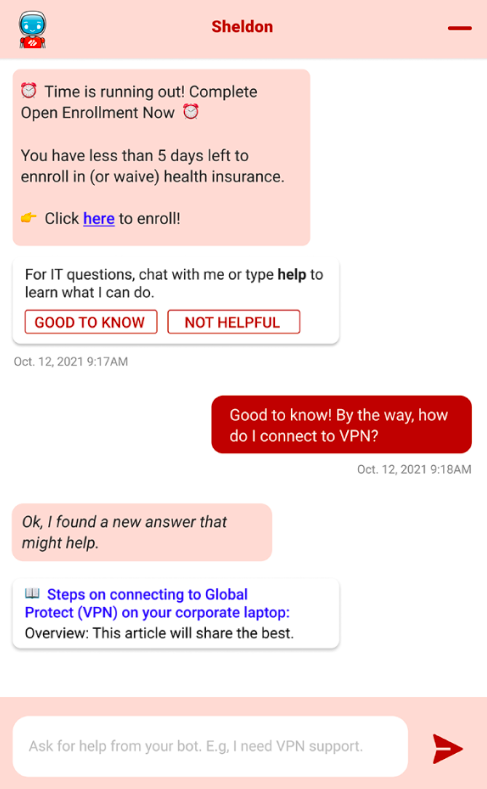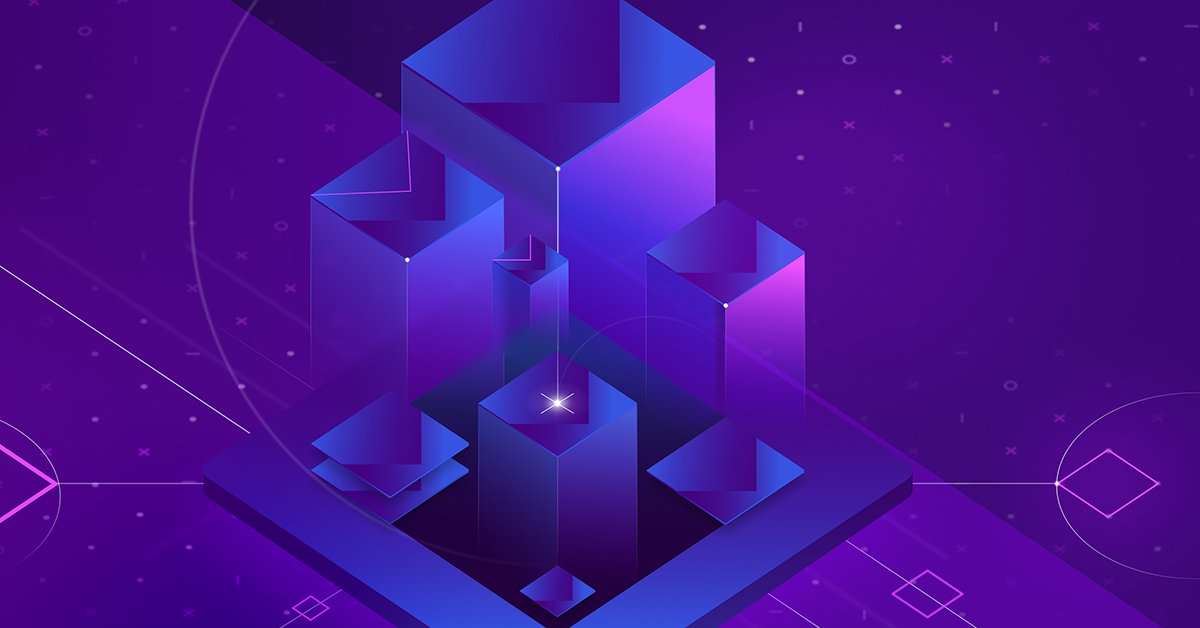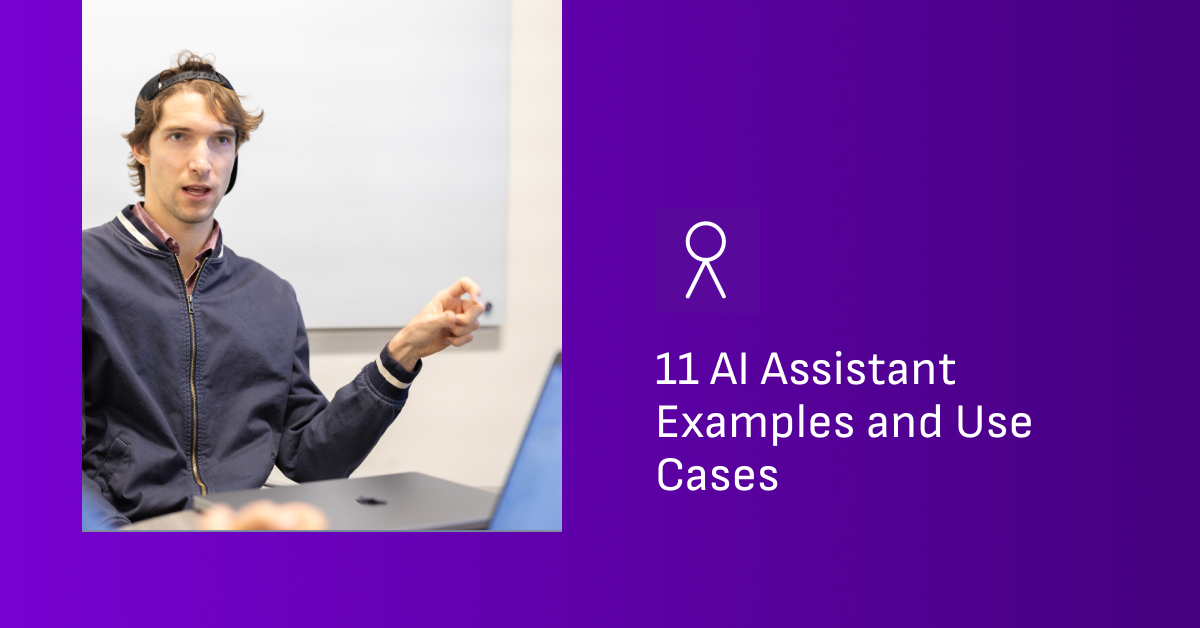Chatbots. Copilots. Digital assistants. Whatever you want to call them, these AI-powered helpers are changing how humans interact with technology across all aspects of work and life. From scheduling meetings to ordering groceries, chatbots are making everything faster, easier, and more accessible.
And now, they're coming for HR.
That's right — chatbots are moving into the world of human resources, and it's high time. HR often gets saddled with time-consuming tasks like fielding frequently asked questions, documenting policies, and onboarding new hires. Wouldn't it be nice if a chatbot could handle some of that busywork?
Well, the future is here. AI chatbots are taking over HR's most tedious tasks, freeing up people managers to focus on more strategic, human-centered work. But are HR chatbots all upside? Or do potential pitfalls remain?
In this blog, we'll break down everything you need to know about HR chatbots. You'll learn:
- What exactly an HR chatbot is
- What the purpose of an HR chatbot is
- If HR chatbots are worth the investment
- The key benefits HR chatbots offer companies and employees
- Challenges in implementing HR chatbots
- Common HR chatbot use cases
- Real-world examples of HR chatbots from forward-thinking firms
Sound useful? Then let's get started and see how chatbots are transforming HR!
What is an HR copilot?
At the base level, an HR chatbot is a virtual assistant that can communicate with employees to provide HR services and information. HR chatbots simulate human-like conversations via text or voice in order to efficiently provide the answer the employee is looking for.
There are three general distinctions you should be aware of: Chatbots, conversational AI chatbots, and copilots. There are clear differences between these with the main difference being the AI that powers them.
- Chatbots usually have dialogue flows or pre-determined paths for the end user to take which have been created by the managing team.
- Conversational AI chatbots are powered by natural language processing (NLP) and are, therefore, more accurately simulate human-like conversation.
- Copilots, with the more recent advancements large language models and domain-specific training, can provide not only information, but they also can take action on behalf of your team.
In essence, HR chatbots act as virtual HR assistants that employees can access anytime they have a question or need help with an HR-related task. For example, an employee could ask the HR chatbot:
- How much vacation time do I have left this year?
- When is our next company holiday?
- How do I enroll in health insurance benefits?
The HR chatbot would then provide the answer immediately, pulling the relevant information from the company's HRIS, knowledge base, or other back-end systems.
Compared to traditional self-service HR portals, chatbots provide a more intuitive and conversational user experience. Employees don't have to dig through FAQ lists or navigate complex menus. They simply ask their question via natural language, just as they would with a human HR rep.
And as artificial intelligence continues to advance, HR chatbots are becoming increasingly sophisticated conversationalists. With machine learning and natural language processing, they can understand complex questions and requests, ask clarifying questions, and even exhibit personality.
The end result is an intelligent virtual assistant that delivers 24/7 HR support and information to employees globally. HR chatbots augment human capabilities, allowing HR staff to focus on more strategic initiatives.
What is the purpose of an HR chatbot?
The main purpose of HR chatbots is to provide instant, consistent and accurate answers to common employee questions. They serve as an always-available HR support resource for the workforce.
More specifically, some key purposes and use cases of HR chatbots include:
- New hire onboarding: HR chatbots help onboard new employees by answering questions about benefits enrollment, company policies, dress code, and more. They can also provide reminders about required training and paperwork.
- Company policy and handbook access: Employees can ask the chatbot questions like "what is the vacation policy" or "when are pay days" to get quick access to HR and company information.
- Benefits support: HR chatbots field benefits-related inquiries about health insurance, retirement plans, and paid time off. This provides employees with 24/7 help.
- HR transactions: Chatbots can complete routine HR tasks like reporting sick days, booking meeting rooms, submitting vacation requests, etc.
- HR contact: When the chatbot cannot answer a question itself, it can connect employees directly with a human HR representative for immediate follow-up.
- HR data analysis: The conversations the chatbot has with employees provide valuable data that HR can analyze to improve processes and the employee experience.
By providing prompt and consistent HR support, HR chatbots improve the employee experience and free up HR staff to focus on high-value strategic tasks. They act as virtual HR assistants for the modern digital workforce.
Why you should invest in HR chatbots
There are several compelling reasons why HR teams should consider implementing an AI-powered chatbot:
- Improved employee experience: HR chatbots provide employees with instant, 24/7 access to HR support and information. This leads to increased employee satisfaction as common questions and needs are addressed quickly and easily via conversational chat.
- Increased HR efficiency: Chatbots automate repetitive, low-value HR tasks like answering common FAQs, providing policy information, and collecting employee documents. This saves HR staff significant time so they can focus on more strategic initiatives.
- Consistent information sharing: Unlike human reps, chatbots provide the exact same answers to common questions every time. This eliminates inconsistency and ensures employees always receive accurate, up-to-date information.
- Expanded HR access: HR chatbots are accessible anytime, anywhere globally through messaging apps, web, mobile etc. This provides HR services to all employees, including remote and frontline workers with limited HR access.
- Valuable HR insights: The conversations an HR chatbot has with employees produce useful data that can reveal opportunities to improve processes, update policies, and enhance programs.
- Cost savings: Chatbots require less investment compared to developing complex HR portals and documentation. The automation also reduces employee requests handled by HR reps, leading to cost reductions.
For these reasons, HR chatbots represent an opportunity to improve operations, free up HR staff, and elevate the employee experience. The ROI and benefits make them a worthwhile AI investment for HR teams looking to modernize.
Key benefits of an HR chatbots
Implementing an AI-powered HR chatbot offers several key benefits for both employees and HR teams:
Speed and accuracy
HR chatbots deliver instant support by providing employees with immediate answers to their questions. There are no delays waiting for HR staff availability. Chatbots also pull answers from curated HR knowledge bases, ensuring employees always receive correct information.
Accessibility
One major benefit of HR chatbots is their accessibility and ability to support a global, distributed workforce. HR chatbots are available 24/7/365 through messaging platforms, enabling employees to get HR help anytime from anywhere. This allows for off-hour support across time zones.
HR chatbots also can be deployed in multiple languages with localization to properly serve employees worldwide. By providing instant, localized support globally, HR chatbots improve access to HR services for all employees, including remote and international team members.
Reductions in busy work
Chatbots automate high-volume, repetitive inquiries from employees, freeing HR staff from monotonous work. They provide answers to frequent questions about topics like:
- Open enrollment
- Company holidays and time off
- PTO accrual and usage
By delivering fast, accurate self-service and automating simple tasks, HR chatbots allow HR teams to focus their time on more strategic, value-added initiatives. This leads to greater efficiency and agility.
To sum up — HR chatbots boost speed, accessibility, and efficiency for both employees and HR departments. Their ability to handle common questions and transactions delivers immense time savings and flexibility.
Challenges in implementing HR chatbots
While HR chatbots offer immense potential, adopting this emerging technology does come with some implementation challenges that organizations should be aware of:
Data privacy and security
Since HR chatbots handle sensitive employee data like health information, compensation, and performance records, data privacy and security is a major implementation concern. Organizations looking to deploy HR chatbots should consider taking these steps:
- Conduct thorough due diligence into vendors' data security protocols. Ensure encryption, access controls, and cybersecurity protections meet industry standards.
- Evaluate which employee data will be shared with the chatbot and its backend systems. Only provide essential data access required for the chatbot's role.
- Anonymize employee data used to train machine learning models to remove personally identifiable information.
- Implement strong access controls defining which HR staff can view or export the employee data collected by the chatbot.
- Establish rigorous data governance procedures for managing and safeguarding HR data within the chatbot system.
- Clearly communicate to employees what data will be collected and how it will be used to maintain transparency and trust.
With thoughtful data privacy and security controls in place, companies can ethically and responsibly leverage HR chatbots while protecting employee personal information and ensuring regulatory compliance.
Change management
Adopting an HR chatbot involves shifting away from traditional HR service delivery models. Employees may be unfamiliar interacting conversationally for HR needs. HR staff can also be initially hesitant to hand over basic tasks to a bot. Careful change management helps ease this transition:
- Roll out the chatbot incrementally, starting with non-critical HR questions to build confidence. Slowly expand its capabilities over time.
- Provide training to employees and HR on how best to leverage the chatbot and integrate it into workflows.
- Measure chatbot adoption metrics and gather feedback to continually refine the user experience.
- Communicate the chatbot’s benefits clearly such as freeing up HR for more strategic work.
With proper communication, training, and iterative improvement, organizations can smoothly onboard employees and HR to embrace AI-assisted HR services.
Onboarding the technology
Implementing an HR chatbot requires selecting either an external vendor solution or building in-house:
- Out-of-the-box solutions like Moveworks offer robust, pre-existing HR knowledge that can be deployed quickly with minimal maintenance needed.
- Building in-house allows for full customization aligned to an organization's unique HR needs. But it demands significant engineering resources for development and continuous training of the AI.
Companies should weigh the pros and cons of buying vs building based on their budget, timeline, and technical capabilities. For most, partnering with an established HR chatbot provider can expedite launching this transformative technology and realizing the benefits. But an in-house solution may make sense for large organizations with ample AI expertise.
Either path forward requires diligent planning, but the ROI makes HR chatbots a smart long-term investment.
HR chatbot use cases?
HR chatbots are versatile tools that can provide value across the entire employee journey from pre-hire to offboarding. Here are some of the key ways chatbots can support the employee lifecycle:
Recruiting and onboarding
- Answer common candidate questions on company culture, benefits, and more
- Streamline screening and scheduling interviews
- Send training reminders and materials to new hires
- Answer questions about benefits enrollment, company policies, dress code, etc.
- Guide new hires through all required onboarding tasks
Employee engagement and development
- Send timely reminders about open enrollment periods or policy changes
- Curate and distribute company news, events, and culture updates
- Proactively prompt employees to complete tasks like performance reviews
- Allow easy scheduling of meetings and rooms
- Collect feedback on employee experience, satisfaction, and engagement
HR knowledge management
- Provide fast answers to employee questions about policies, PTO, compensation, etc.
- Enable easy access to HR database of FAQs, documents, training materials
- Support common HR transactions like reporting sick days, booking leave, submitting expenses
Analytics
- Track HR support requests to identify gaps needing additional content
- Analyze conversational data to surface employee trends, concerns, and sentiment
HR chatbots are versatile AI assistants that can automate tedious tasks while providing personalized support across the entire employee lifecycle from pre-hire to alumni. Their wide range of impactful use cases makes them a valuable tool for optimizing HR processes.
What are the real-world use cases of an HR chatbot?
HR chatbots are already delivering transformative impact at leading companies worldwide. Let's explore how forward-thinking organizations are leveraging this emerging technology to optimize HR operations and the employee experience.
Albemarle's HR chatbot drives digital transformation
Global chemical manufacturer Albemarle turned to AI chatbot technology to provide better HR support and empower their 6,000 employees.
The company launched a Moveworks-powered HR chatbot named ALbot in 2021 to give workers instant self-service for common HR questions and transactions. ALbot aggregates data from across disconnected backend systems, pulling precise snippets of, for example, a parental leave policy personalized to the requestor’s location.
The chatbot proved so effective that soon facilities, IT, and other departments requested their own AI solution. As Albemarle's CIO Patrick Thompson noted, "Everybody [was asking if they could] have a bot. So all these other departments are now using [our chatbot] as well."
ALbot's ability to aggregate data across Albemarle's disconnected systems and consistently serve employees enabled the company's digital transformation. Employees enjoy fast, 24/7 HR assistance. HR staff are freed from repetitive tasks to focus on strategic initiatives.
Most importantly, ALbot provides data-driven insights into the pain points slowing employees down the most. As Thompson said, "With consistent support across departments, we can raise everybody's game."
 Figure 1: By leveraging AI analytics, Moveworks Employee Experience Insights can identify specific team-related issues, enabling support teams — such as HR — to address and resolve these problems before they escalate.
Figure 1: By leveraging AI analytics, Moveworks Employee Experience Insights can identify specific team-related issues, enabling support teams — such as HR — to address and resolve these problems before they escalate.
Palo Alto Networks' HR chatbot enables flexible work
Cybersecurity firm Palo Alto Networks deployed an AI chatbot called Sheldon to provide HR support as they shifted to flexible work models.
With nearly 15,000 globally distributed employees, Palo Alto Networks needed an efficient way to handle HR requests and questions at scale. Sheldon allows employees to get HR help instantly in natural conversations across channels.
Now adopted company-wide, Sheldon automates thousands of HR issues monthly including benefits, payroll, and policy inquiries, allowing HR staff to focus on more strategic initiatives. The one-stop shop approach is why almost every Palo Alto Networks employee has used Sheldon to get support, adding up to thousands of issues automated per month and even more time savings. After saving 351,000 hours of productivity with Moveworks, and counting, it’s safe to say Palo Alto Networks succeeded.
Sheldon enabled Palo Alto Networks to realize their vision for flexible work by providing fast, personalized HR support to employees anytime, anywhere. The chatbot empowered a distributed workforce while maximizing HR's impact.
 Figure 2: With AI-powered comms, you can target your messages to employees based on their role, department, and location — so no important message gets lost in a crowded inbox.
Figure 2: With AI-powered comms, you can target your messages to employees based on their role, department, and location — so no important message gets lost in a crowded inbox.
Solidigm's HR chatbot centralizes workplace support
Leading data storage provider Solidigm relies on an AI chatbot to enable easy access to HR support for their global workforce.
Solidigm's CIO Steve Phillpott described the chatbot as "the core of our digital workplace, since it lets employees access support for the broader tech stack with a single search." It empowers employees by providing fast, centralized assistance.
The chatbot allows Solidigm's HR team to deliver personalized support efficiently to over 1,000 distributed team members. As HR Operations Manager Lainey Dailo explained:
"Moveworks navigates this complexity for us, which means our people get the personal touch they expect from HR, but without having to wait."
By pairing HR expertise with AI, Solidigm streamlined access to HR services globally. The chatbot improved experience while enabling targeted human support.
Vituity's HR chatbot empowers physicians
Leading healthcare provider Vituity deployed an AI chatbot called Otto to instantly resolve HR issues for their 5,000 physicians. This allows doctors to stay focused on patient care.
Previously, HR requests took days to address, disrupting physician productivity. Now with Otto, powered by conversational AI, doctors get HR answers in seconds right within Microsoft Teams.
Otto automates repetitive HR tasks like benefits questions and paperwork. Vituity's CIO Amith Nair noted Otto is central to their support strategy: "Automation and AI are at the core of our support strategy. Ultimately, where we’re headed is that Otto can solve every [HR] issue."
By providing fast, self-service HR support, Otto improved experience and productivity for time-constrained physicians. The chatbot optimized Vituity's HR operations to better empower doctors to focus on what matters — their patients.
 Figure 3: An HR chatbot can automatically inform the affected team members when actions need to be taken so you know that your entire workforce stays connected and knows exactly what’s changing.
Figure 3: An HR chatbot can automatically inform the affected team members when actions need to be taken so you know that your entire workforce stays connected and knows exactly what’s changing.
HR chatbots offer a roadmap for workplace excellence
The time has come to leverage HR chatbots' potential. With careful implementation, they optimize operations, unlock savings and enrich the employee journey. HR teams that embrace chatbots send a powerful message that they are innovators committed to transparency and people.
Chatbots provide a clear roadmap for the future of HR excellence. The opportunity is here to transform HR, serving both employees and the business more meaningfully. AI empowers this evolution, but HR remains the guiding human hand. By combining the best of technology and humanity, chatbots elevate HR to its highest purpose: building a great place to work.
Give HR an upgrade with an AI-powered chatbot. Learn more!
Table of contents



